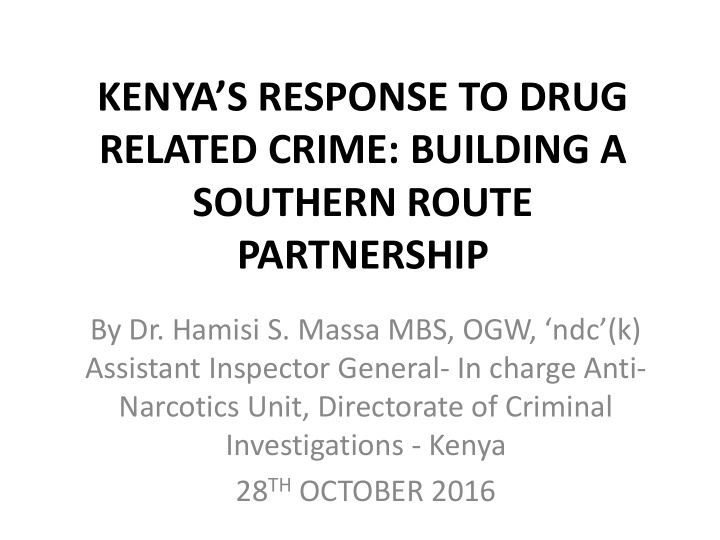



KENYA’S RESPONSE TO DRUG RELATED CRIME: BUILDING A SOUTHERN ROUTE PARTNERSHIP By Dr. Hamisi S. Massa MBS, OGW, ‘ndc’(k) Assistant Inspector General- In charge Anti- Narcotics Unit, Directorate of Criminal Investigations - Kenya 28 TH OCTOBER 2016
1.0 Introduction • According to the World Drug Report (UNODC 2013), trends on new emerging routes for trafficking of drugs and production of illicit substances indicate that Africa is increasingly becoming vulnerable to the drug trade and organized crime. • Cannabis remains the most abused narcotic drug in the country at 5.4% in 2012 compared to heroin and cocaine whose prevalence is still statistically low. Despite a marginal reduction in the use of any alcohol from 14.2% in 2007 to 13.3% in 2012, increased use of traditional liquor was recorded, a trend considered as an initiation into hard drug use.
2.0 Emerging Issues • Rising trafficking trend of illicit drugs • Growing consumer market • Illicit drug trafficking linked to other forms of organized crime • Illicit cash flows to facilitate crime • Undermining of Social, Political and Economic structures and threatening of stability and security.
3.0 Current Situation of Narcotic Trafficking in Kenya COMPARATIVE SIGNIFICANT SEIZURES: 2013 – 2015 (KG ) 2013 2014 2015 TOTAL CANNABIS 6144 6290.5 4356.5 16791 HEROIN 79.20 395.20 39.49 513.89 COCAINE 10.32 11.30 5.96 27.58 METHAM- 8.20 0 3.05 PHETAMINE 11.25 EPHEDRINE 39.10 0 18.19 57.29
HEROIN 2013 2014 2015 TOTAL KENYANS 17 16 31 64 TANZANIANS 3 7 5 15 NIGERIANS 3 3 2 8 LIBERIANS 1 0 0 1 CANADIAN 1 0 0 1 GUINEAN 1 0 2 3 IVORIAN 1 0 0 1 KHAZKISTAN 1 0 0 1 LUTHUANIAN 1 0 0 1 UGANDAN 0 1 0 1 INDIANS 0 2 0 2 PAKISTANIS 0 6 0 6 IRANIANS 0 1 0 1 SEYCHELLOIS 0 0 1 1 TOTAL 29 36 41 106
4.0 Maritime interdictions 1. 377.224 kgs of Heroin seized Al Noor also known as Amin Darya vessel was intercepted at Mombasa Port in July 2014. 377.224 kgs of Heroin were seized. 10 suspects arrested – 7 Pakistanis, 2 Indians and 1 Iranian. Routing – Iran – UAE- Kenya. The hearing is ongoing. The vessel and the drugs were destroyed (blown up on 29 th August 2016 in the sea)
2. 7.6kgs of Heroin seized from a yatch Baby iris Yacht was intercepted at Kilifi Boat Yard in April 2015. 7.6kgs of Heroin was concealed in the ballast compartment. The routing – Kenya – Madagascar. Four suspects before court one Seychellois who was the Pilot. Hearing ongoing but the boat and the drugs were destroyed in the sea. (Blown up with explosives on 4 th August 2015)
3. 99 kgs of Cocaine seized from a Container. The Cocaine was seized at the Port of Mombasa on 28 th August 2016 concealed in a container of 520 bags of sugar. The routing was – Brazil – Spain - Oman – Kenya. The case is Pending Before Court with two suspects arraigned in court.
5.0 Challenges Enforcement challenges • A world much interlinked : Interconnectivity highly dependent on open borders & movement of persons, goods and services. • Conceptual discourses at national, regional and international level: Too many ideas/Issue of security/issue of jurisdiction/Issue of mandate/Sovereignty/human rights
• The mechanisms for supply suppression by various law enforcement agencies on drug issues are still insufficient. The surveillance system on narcotic counter-measures is limited by the transnational nature of the crime. This creates gaps in supply suppression initiatives. • Piecemeal domestication of international treaties and agreements limits the illicit drug control. Different partner states remain at different levels in implementation, a situation that limits progress in international initiatives.
• Institutional arrangement for asset recovery is identified as critical to deal with proceeds of crime. This is complicated by money laundering that knows no borders. • The influence of huge money through money laundering and corruption on prosecution and financial and monetary systems at transnational level undermine state responses.
6.0 Conclusion The country anti drug responses focus on; Strengthening the strategies in demand reduction and supply suppression through policy initiatives; Strengthening institutional capacity for drug supply suppression; Developing comprehensive prevention programs so as to reduce demand of drugs of abuse; and Strengthening inter-sectoral coordination and collaboration amongst stakeholders .
7.0 Key areas of support Drug trafficking is a transnational crime that requires a multidisciplinary approach with collaboration networks that reinforce regional approach against demand and supply. To enhance operational efficiency in the fight against illicit drug trade, the following support areas are critical; 1. Enhanced border surveillance and Interstate collaboration. By curtailing the flow of drugs across our borders, we reduce drug availability throughout our region and greatly reduce the consequences of drug abuse and trafficking in our communities. This can be enhanced through bilateral and multilateral forums on information sharing.
2. Counter-Drug Intelligence Drug intelligence and information collection, analysis, and dissemination are essential for effective drug control. Drug- control efforts could be better supported by drug intelligence and law-enforcement information. We need to develop tools on information and technology for counter drug intelligence. 3. Strengthening public institutions through foreign assistance . Supply reduction can be achieved through building consensus through bilateral, regional, and global accords and conducting coordinated investigations and interdiction. Also control of precursors and promotion of anti-money-laundering initiatives.
4. National and Human Security Development of coherent policies to reduce tendencies of indulging in drug cultivation, production, trafficking and money laundering. 5. Public – Private Partnership Working together with the private sector should be encouraged and can go a long way in deterring drug smuggling via legitimate commercial shipments and conveyances.
THANK YOU
Recommend
More recommend